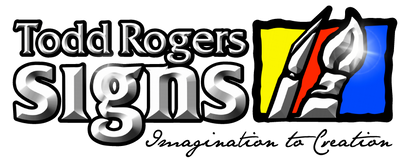🔍 Signage Secret #1: Why Contrast Beats Font Size Every Time
When it comes to signage, bigger isn’t always better. You might think that cranking up the font size is the key to grabbing attention—but the real hero of visibility is contrast.
At Todd Rogers Signs, we’ve seen it all: oversized text that fades into the background, and modest lettering that pops like a spotlight. The difference? Contrast. It’s the unsung design element that determines whether your message gets noticed or ignored.
👀 What Is Contrast, Really?
Contrast is the visual difference between elements—typically between text and background. High contrast means your lettering stands out clearly. Think white text on black, or bold yellow on navy. Low contrast, on the other hand, blends into the background and forces the viewer to squint or skip.
In signage, contrast affects:
- Readability from a distance
- Speed of recognition (especially for drivers or passersby)
- Visual hierarchy—what the eye sees first
📏 Why Size Alone Doesn’t Cut It
Sure, large fonts help—but only if they’re legible. A giant word in pale grey on a white background won’t do much for visibility. In fact, poor contrast can make big text harder to read than smaller, well-designed lettering.
We’ve had clients come in asking for “the biggest font possible,” and we always ask: “Where will this sign live?” Because size without contrast is like shouting in a whisper.
🧠 How the Brain Processes Signs
Studies show that the human brain processes high-contrast visuals faster than low-contrast ones. That’s why road signs use white text on green or black on yellow—it’s not just tradition, it’s science.
When someone glances at your sign, you’ve got about 3–5 seconds to make an impression. High contrast helps your message land instantly, while low contrast forces the viewer to work harder—and most won’t bother.
🎨 Todd’s Tips for Maximum Impact
Here’s how we approach contrast in our workshop:
- Start with your brand colours, but don’t be afraid to tweak them for visibility. A slightly darker background or brighter text can make all the difference.
- Test your design in grayscale. If it’s still readable without colour, your contrast is solid.
- Avoid busy backgrounds. Patterns and gradients can compete with your text. Keep it clean.
- Use bold fonts with clear edges. Thin or script fonts can disappear against certain colours.
And most importantly—consider the environment. A sign that looks great on screen might vanish in real-world lighting. We always ask: will this be seen in daylight, under artificial light, or in shade?
💬 Final Word
Contrast isn’t just a design detail—it’s the backbone of effective signage. It’s what makes your message readable, memorable, and impactful. So next time you’re planning a sign, don’t just think big—think bold.
At Todd Rogers Signs, we design with visibility in mind. Because your brand deserves to be seen, not squinted at.



